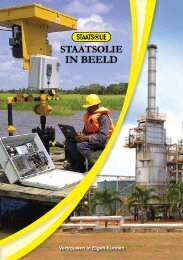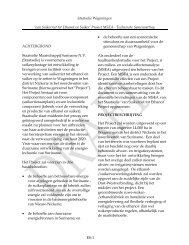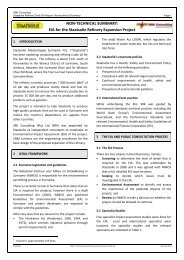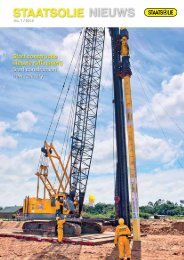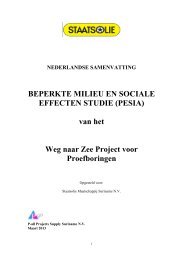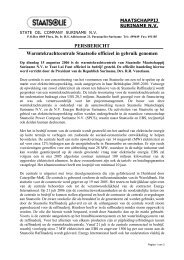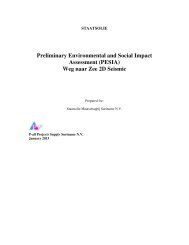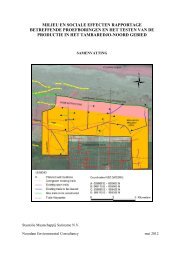(PESIA) Weg naar Zee 2D Seismic - Staatsolie
(PESIA) Weg naar Zee 2D Seismic - Staatsolie
(PESIA) Weg naar Zee 2D Seismic - Staatsolie
You also want an ePaper? Increase the reach of your titles
YUMPU automatically turns print PDFs into web optimized ePapers that Google loves.
P-all consultants <strong>Staatsolie</strong> Maatschappij Suriname N.V.<br />
<strong>PESIA</strong> <strong>Weg</strong> <strong>naar</strong> <strong>Zee</strong> <strong>2D</strong> <strong>Seismic</strong> 2012<br />
4.2.7 HYDROLOGY<br />
As indicated above, the study area can be divided in a “Wetland Area” and a “Dry land Area”.<br />
These two areas are therefore discussed separately.<br />
Wetland Area<br />
The Surinamese coastal region has about 2,000 km² of brackish wetlands with mangrove forest,<br />
salt water lagoons and brackish herbaceous swamps, and 12,000 km² of freshwater wetlands<br />
(Teunissen, 1988). In the Eastern Wayambo Swamp about 110 km² of coastal wetland is found,<br />
of which less than 15% is mangrove forest.<br />
All projected seismic trails are found crossing the well-drained dry land area and the freshwater<br />
swamps with poorly to very poorly drained soils, which are inundated either permanently or at<br />
least during the greater part of the year (Teunissen, 1993). The higher parts of the ridges, found<br />
as small and narrow islands surrounded by the swamps, remain dry throughout the year.<br />
Swamps are formed because the low-lying clay flats have a very slow drainage, due to:<br />
• the small hydraulic gradient<br />
• the very low permeability of the soil<br />
• the dense layer of vegetation and peat on top of the soil<br />
But although the flow through peat and vegetation is very slow, a considerable amount of water<br />
will be discharged due to the large areas over which the process takes place.<br />
Creeks, to either a local river or to the Atlantic Ocean, are usually only found along the edges of<br />
these swamps where both water velocity and discharge may be high.<br />
The Wayambo Swamp drains towards the Atlantic Ocean in the north and towards the<br />
Saramacca River in the west. The flow to the north is thought to account for the majority of the<br />
drainage of the Eastern Wayambo Swamp. The latter is supported by the generally northern<br />
direction of watercourses (shallow swamp gullies) in the Wetland Area.<br />
Natural drainage from this swamp towards the south and east is not easily possible because<br />
ridges and roads block the flow in these directions.<br />
During the rainy season the water level in the Eastern Wayambo Swamp is high (up to 80 cm<br />
above the mineral surface) and water is permanently being discharged towards the Atlantic<br />
Ocean. With diminishing rainfall at the end of the rainy season, with gradually lowering swamp<br />
water levels, the amount of drainage also decreases. At a certain water level the drainage from<br />
the swamp will virtually stop and water will mostly be depleted by evapotranspiration. However,<br />
in most years a shallow layer water remains present in the swamp and the peat does not<br />
completely dry up, (Noordam and Teunissen 2007/2008).<br />
But in years with an extremely long dry period, the swamps, including peat, will completely dry<br />
up.<br />
Starting at the Garnizoenspad, a number of S-N running canals has been excavated. These canals<br />
are intended to collect swamp fish in the Dry season, when water level becomes low. Therefore<br />
these canals are referred to as “fish holes”. Most of these canals are rather short and none reach<br />
the Atlantic Ocean. From satellite imagery it appears that part of these canals is no longer being<br />
used.<br />
43





